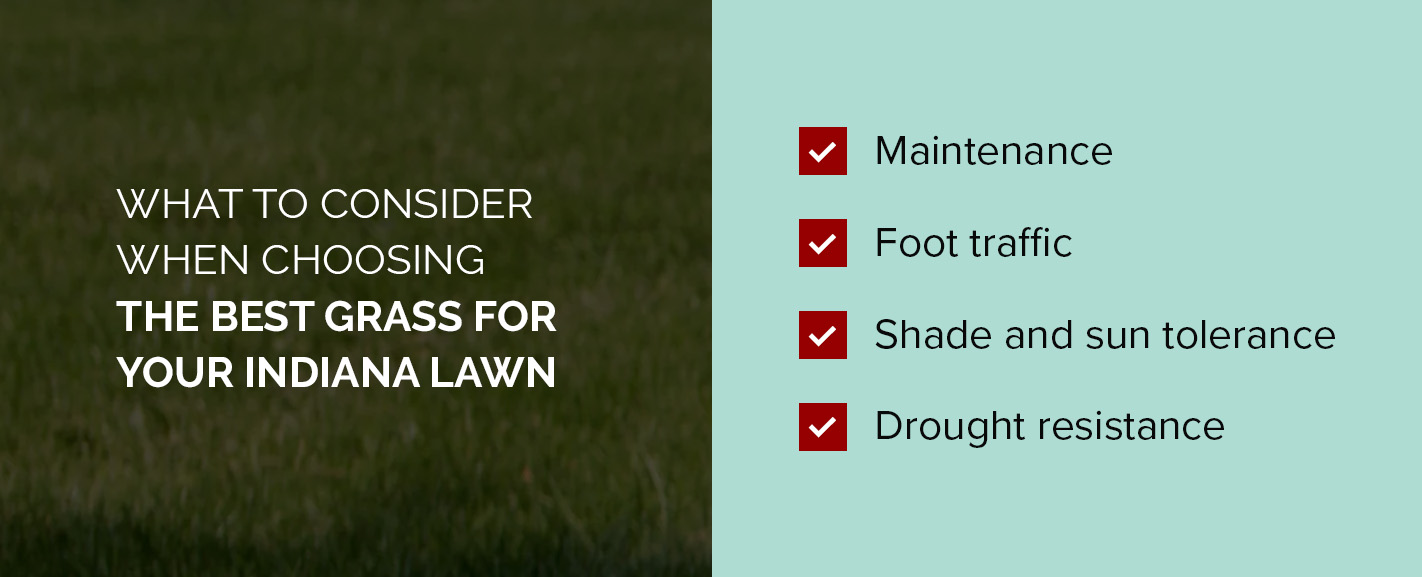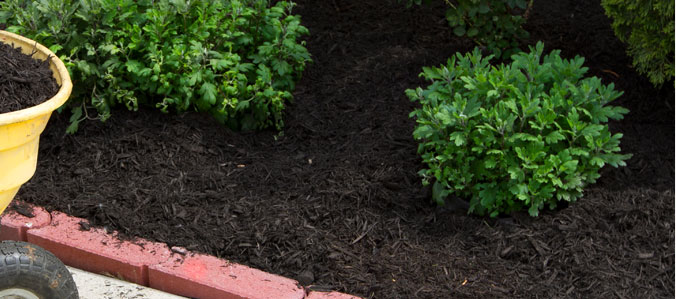What Is the Best Grass Seed for Indiana Lawns?

Look closely at what’s under your feet, and a discerning eye can tell that not all yard grass is the same. There are many varieties of grass seed mixtures sold for Indiana lawns today, resulting in different textures, colors and consistencies. That’s why achieving a healthy, lush lawn involves understanding your environment and the various grass types.
Read on to learn more about the best grass seeds for Indiana and which factors to consider when choosing a seed for your lawn.
Cool-Season Grass vs. Warm-Season Grass
Grasses are typically categorized as either warm-season or cool-season grasses. Understanding the difference between the two is essential when choosing a seed for your lawn.
Warm-season grasses thrive in areas with hotter summers but gentler winters. Warm-season variants produce new growth from the summer to the beginning of fall and go dormant throughout the winter. When a lawn enters dormancy, it essentially hibernates to survive weather changes. During this period, your grass may turn brown or yellow.
Cool-season grasses are more suited to colder areas with longer and more extreme winters — they don’t go dormant during this season. Instead, they start growing from the end of winter to the beginning of spring. As a result, many homeowners choose cool-season grasses to achieve a beautiful lawn all year round.
Best Indiana Lawn Grasses
Indiana falls within zones five to six, meaning zero to negative 20 degrees Fahrenheit is our average coldest temperature in the winter. Due to the state’s long shape, the northern half has a slightly different climate than the southern areas. The south gets more rain but warmer winter temperatures than the north.
While cool-season varieties tend to do well throughout the region, those in southern Indiana can get away with warm-season grasses. On the other hand, cool-season variants are the best grass seed for Northern Indiana.
Some of the most ideal grasses for Indiana lawns are:
- Bluegrass
- Fine fescues
- Tall fescue
- Perennial ryegrass
- Zoysia grass
Except for zoysia grass, all of the above are cool-season variants. As they can handle the changing weather, they are a good choice regardless of where you are based in the state.
Bluegrass
Perhaps the most popular and versatile grass for area lawns, bluegrasses have a fine texture and are the preferred choice for sunbathed areas.
You must regularly fertilize and water bluegrass to preserve its quality. While it takes several months to establish, it’s quite hardy through the winter.
Fine Fescues
This category contains multiple varieties, such as red, hard and chewings fescues.
Fine fescues have narrow blades and readily tolerate the shade, so it’s not uncommon to mix these seeds with other types to boost chances of survival out of the sun. You also don’t need as much fertilizer to keep fine fescue grasses in top shape. However, they have low wear resistance.
Tall Fescue
As a longer clump-type grass, tall fescue is a low-maintenance choice with deep roots to wrangle weeds as well as endure high foot traffic and wear.
While moderately shade-tolerant, tall fescue excels in withstanding heat and drought during the occasional harsh summer.
Perennial Ryegrass
Often, perennial ryegrasses get blended into bluegrass or fescue seed varieties. This type of grass seed establishes the fastest, aids in repairing patchy areas and adds a deeper green color to your lawn.
While perennial ryegrass is not as cold-tolerant and doesn’t perform well in constant shade compared to other Indiana grass types, it has high wear resistance.
Zoysia Grass
This variant is known for being one of the most heat- and drought-resistant lawns. Thanks to its deep roots, which can absorb groundwater, it can survive extended periods without rain. It can also withstand significant foot traffic and wear.
Zoysia grass is only suited to specifc areas in southern Indiana as a warm-season grass — it doesn’t handle the cold very well.
What to Consider When Choosing The Best Grass for Your Indiana Lawn

Along with selecting a variety that is suited to the weather, keep the following factors in when choosing the best grass seed for your lawn:
- Maintenance: Determine how much time and effort you want to spend maintaining your lawn. Bluegrass must be frequently watered and fertilized. Fine or tall fescues are better options if you want something more low-maintenance.
- Foot traffic: Consider how you want to use your lawn. If you plan on having regular barbeques or know that children will use the lawn as a play area, choose a grass that can handle high foot traffic, such as zoysia, perennial ryegrass and tall fescue. These are also good choices if you have dogs.
- Shade and sun tolerance: Think about whether your lawn receives a lot of sunlight. While perennial ryegrass and fine fescues do well in the shade, bluegrass needs the sun to grow. Tall fescue can thrive in both partially shaded areas and those that are fully exposed to the sun.
- Drought resistance: With almost 33% of Indiana residents experiencing drought conditions in 2024, choosing drought-resistant grass is a wise decision. Zoysia and tall fescue can handle dry spells with little water.
When to Plant Grass Seed in Indiana
Early fall — from about mid-August to early October — is the best time to plant grass seed in Indiana. If you try planting grass in the spring after the thaw, it may work, but conditions aren’t as favorable. The ground is chillier, and spring downpours can oversaturate the soil and disrupt the grass growth.
Here’s why early fall is a suitable planting season for Indiana seeds:
- The soil is still warm from the summer, about 50 to 65 degrees Fahrenheit.
- Weed growth slows during the fall, reducing the competition over sunlight, water and nutrients.
- Two months before the first anticipated frost is ample time for the roots and promotes a denser covering for the following spring.
How to Prepare Grass for Winter in Indiana
Once your lawn has grown, there is still work that needs to be done to keep it healthy — especially during the winter. Even cool-season grasses need adequate preparation before the temperatures drop before freezing, which can bring about potentially determinantal conditions. For example, ice buildup from heavy snowfall can cause damage, such as snow mold, which may kill your lawn.
You can avoid paying for expensive repairs and disease treatment by taking the following protective measures at the end of the fall:
- Remove leaves and debris: A thick and heavy layer of leaves and sticks may suffocate your lawn, trapping moisture underneath and encouraging mold growth. Get rid of excess debris and leaves, and prune trees to help prevent fallen branches.
- Mulch the leaves: Rather than disposing of the leaves that you cleared, mulching them can create an added layer of protection. Mow over fallen leaves to shred them into smaller pieces and turn them into compost.
- Cut your lawn: Since you won’t likely be mowing your lawn during the snowy months, cut your grass shorter with one last mow. This can help promote stronger root development in preparation for spring.
- Use a winterizer: Applying such a fertilizer is essential to maintaining your lawn’s health throughout winter, as these formulas can help encourage faster and brighter growth in spring.
Rely on Ricci’s Landscape Management for Lawn Sculpting, Maintenance and More in Northwest, IN
Choosing the right grass for your grounds is simple when you have RLM’s specialists to guide you. We’re a full-service lawn care and landscaping company specializing in customized growth and maintenance plans.
To speak with one of our experts, request a quote today!









One Response
This design is steller! You obviously know how to keep a reader entertained. Between your wit and your videos, I was almost moved to start my own blog (well, almost…HaHa!) Excellent job. I really loved what you had to say, and more than that, how you presented it. Too cool!